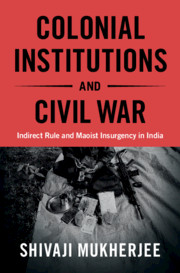Book contents
- Colonial Institutions and Civil War
- Cambridge Studies in Contentious Politics
- Colonial Institutions and Civil War
- Copyright page
- Contents
- Figures
- Tables
- Acknowledgments
- Part I Theory
- Part II Qualitative and Quantitative Testing
- 4 Qualitative Analysis of Maoist Strategy and Rebel Agency
- 5 Quantitative Testing of Effects of British Indirect Rule on Maoist Insurgency
- 6 Colonial Choice or Random Contingency? Addressing Selection Bias in British Indirect Rule
- 7 Maoist Insurgency in Chhattisgarh: The Raja of Bastar and Tribal Rebellion
- 8 Maoist Insurgency in Andhra Pradesh: The Nizam’s Shadow on Telangana
- Part III Generalizability
- Bibliography
- Index
- Series page
7 - Maoist Insurgency in Chhattisgarh: The Raja of Bastar and Tribal Rebellion
from Part II - Qualitative and Quantitative Testing
Published online by Cambridge University Press: 15 May 2021
- Colonial Institutions and Civil War
- Cambridge Studies in Contentious Politics
- Colonial Institutions and Civil War
- Copyright page
- Contents
- Figures
- Tables
- Acknowledgments
- Part I Theory
- Part II Qualitative and Quantitative Testing
- 4 Qualitative Analysis of Maoist Strategy and Rebel Agency
- 5 Quantitative Testing of Effects of British Indirect Rule on Maoist Insurgency
- 6 Colonial Choice or Random Contingency? Addressing Selection Bias in British Indirect Rule
- 7 Maoist Insurgency in Chhattisgarh: The Raja of Bastar and Tribal Rebellion
- 8 Maoist Insurgency in Andhra Pradesh: The Nizam’s Shadow on Telangana
- Part III Generalizability
- Bibliography
- Index
- Series page
Summary
I use archival and fieldwork-based qualitative data to do process tracing of the causal mechanisms of the crucial pathway case of the Maoists in Chhattisgarh. The northern and southern parts of Chhattisgarh had colonial indirect rule through feudatory princely states, which created weak state capacity and despotic extraction of land revenue and natural resources through landlords and feudatory chiefs. This created tribal grievances that persisted in the postcolonial period in the 1950s-80s through path dependence of these mechanisms, which were mobilized by the People’s War Group (PWG) Maoists, leading to high levels of Maoist rebel control by the 1990s. In contrast the central districts of Raipur and Bilaspur had been under British direct rule and had relatively higher levels of development and less exploitation of forest and natural resources of tribals, and so the Maoists did not succeed there. I describe the history of the PWG Maoists and how they contributed to the welfare of the tribals and opposed natural/forest resource exploitation, which highlights the role of rebel agency. Finally, I develop a novel constituency-level dataset to test the theory and show that former princely state constituencies had more Maoist control.
Keywords
- Type
- Chapter
- Information
- Colonial Institutions and Civil WarIndirect Rule and Maoist Insurgency in India, pp. 184 - 245Publisher: Cambridge University PressPrint publication year: 2021



